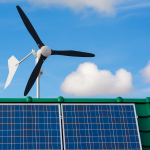- There is no permanent, statewide ban on crypto mining in New York. The state enacted a two‑year moratorium (11/22/2022–11/22/2024) on certain new or renewed permits for proof‑of‑work (PoW) mining projects that draw “behind‑the‑meter” power from fossil‑fuel plants; that pause has expired. The same law ordered a statewide environmental study. Department of Environmental Conservation
- After the pause ended, mining remained legal but is being shaped by environmental permitting under New York’s climate law (CLCPA) and by local zoning/noise rules. The Department of Environmental Conservation (DEC) published a Draft Generic Environmental Impact Statement (GEIS) in May 2025 to inform future policy. Department of Environmental Conservation
- Regulators are enforcing climate rules case‑by‑case. DEC denied the Greenidge gas plant’s air‑permit renewal (used for PoW mining); a judge later remanded part of the decision for further review, allowing operations to continue for now — but affirmed DEC’s authority to apply the CLCPA. Department of Environmental Conservation
- Local governments are acting. North Tonawanda adopted a two‑year local moratorium on new crypto mines in 2024; Niagara Falls tightened zoning and noise limits and pursued enforcement actions against violators. Times Union
- What’s new in 2025: Lawmakers introduced S.8518, a bill to tax electricity used by PoW mining on a tiered per‑kWh basis, directing the proceeds to low‑income Energy Affordability Programs (bill introduced; not law as of publication). The bill text also outlines an exemption for certain off‑grid renewable energy mining. New York State Senate
- Longer‑running pressures: Since 2018, New York’s utility regulator has let municipal utilities charge special high‑density‑load rates to energy‑intensive customers such as crypto miners. Utility Dive
The headline vs. reality
“New York bans cryptocurrency mining” makes for a punchy headline, but it’s not accurate. In November 2022, New York enacted the nation’s first targeted pause on new or renewed permits for PoW mining projects that power themselves with fossil‑fuel plants behind the meter. It did not outlaw mining, and it did not touch operations powered by the grid or renewables. The pause expired on November 22, 2024. Department of Environmental Conservation
Crucially, that same law required DEC — alongside the Department of Public Service — to produce a comprehensive environmental study of PoW mining’s impacts statewide. DEC released a Draft GEIS in May 2025; it summarizes what’s known, what isn’t, and policy options New York could consider next. Department of Environmental Conservation
What the state’s 2025 study says
The Draft GEIS identifies 11 known crypto‑mining facilities operating in New York (based on public sources). Assuming they all run PoW at full capacity, DEC estimates total annual electricity demand around 7.7 TWh and ~3 million metric tons of CO₂‑equivalent emissions — with most load connected to the grid and a smaller share coming from behind‑the‑meter generation. DEC stresses these are assumptions given data gaps (miners aren’t required to report load). Department of Environmental Conservation
The document also lists policy options for lawmakers and agencies — from requiring disclosure of energy sources and emissions and demand‑response participation, to steering mining toward zero‑emission power or managing noise and e‑waste. It’s not a rulebook; it’s meant to inform decisions. Department of Environmental Conservation
Enforcement through New York’s climate law (CLCPA)
Even without an active moratorium, projects must pass air and environmental permitting tests that incorporate the CLCPA, which mandates deep statewide emissions cuts (–40% by 2030; –85% by 2050 from 1990 levels). That standard helps explain why DEC denied the Greenidge Generation gas plant’s air‑permit renewal in 2022 (and again in a 2024 decision), citing climate consistency. In late 2024, a state judge sent the matter back to DEC for further review, allowing Greenidge to keep operating for now — but the ruling recognized DEC’s authority under the CLCPA framework. Department of Environmental Conservation
(CLCPA targets: –40% by 2030; –85% by 2050. These are the official statewide goals.) Department of Environmental Conservation
Local rules: moratoriums, zoning, and noise
While state policy evolves, local governments continue to shape siting and community impacts:
- North Tonawanda (Erie/Niagara County) adopted a two‑year moratorium on new crypto mines in 2024 as residents pressed for action on noise and emissions. Existing operations were not shut down by the local pause. Times Union
- Niagara Falls revised zoning and set decibel caps for “high‑energy‑use” industries, then pursued court enforcement against non‑compliant facilities — resulting in shutdown orders and later settlements tied to noise mitigation and permits. GovTech
Expect more towns to copy these playbooks: temporary pauses to study impacts, new noise ordinances, industrial siting buffers, and permit conditions on cooling, e‑waste, and traffic.
The 2025 twist: a proposed electricity excise tax on PoW mining
Introduced in October 2025, S.8518 (Krueger) would tax electricity used by PoW mining in tiers (0–5¢/kWh depending on annual consumption) and channel the proceeds to Energy Affordability Programs for low‑income customers. The bill text also carves out an exemption for electricity produced by certain renewable systems that are off‑grid (not connected to utility transmission/distribution). The proposal has been referred to committee and is not law. New York State Assembly
Why it matters: if enacted, the tax could materially change project economics for grid‑tied PoW miners, while reinforcing an incentive to co‑locate with dedicated renewable generation. New York State Assembly
Don’t forget rates: New York’s long‑running utility lever
Separate from environmental permitting, New York’s Public Service Commission in 2018 authorized municipal utilities to apply special “high‑density load” tariffs to energy‑intensive customers — a bucket that includes crypto miners. That authority, still relevant today, gives local utilities a tool to recover costs and manage community impacts. Utility Dive
What’s allowed right now?
- Mining is legal statewide. The 2022 moratorium has ended. New projects must clear state environmental review and any local zoning/noise rules. Department of Environmental Conservation
- Behind‑the‑meter fossil‑powered expansions face the toughest headwinds given CLCPA consistency and recent permit outcomes. Department of Environmental Conservation
- Grid‑connected projects still proceed — but should plan for rate design scrutiny, emissions accounting, demand‑response participation, and community noise limits. Utility Dive
The Greenidge case, briefly: a bellwether
- June 30, 2022: DEC denies air‑permit renewal for Greenidge Generation (gas‑fired plant powering PoW mining). Department of Environmental Conservation
- May 8, 2024: DEC issues another decision denying the renewal. Earthjustice
- November 2024: A judge remands the matter to DEC for further proceedings, and the plant continues operating pending review — but DEC’s authority under climate law is not struck down. AP News
Takeaway: Permits are the battleground. Even without a ban, CLCPA‑based permitting and litigation can decide outcomes.
What to watch through 2026
- Final DEC GEIS & follow‑on rulemaking. The Draft will be refined; expect discussion of reporting requirements, demand‑response, noise, water use, and possible emissions standards for PoW operations. Department of Environmental Conservation
- S.8518 (electricity excise tax) progress. Committee hearings, fiscal notes, and whether off‑grid renewables remain exempt in the final language. New York State Assembly
- Local siting playbooks. More temporary moratoriums and zoning overlays as towns translate state guidance into on‑the‑ground rules. Times Union
- Utility rate cases. Watch how utilities and municipal systems apply high‑density load tariffs as demand grows or shifts. Utility Dive
- Litigation over permits. Greenidge won’t be the last test of how the CLCPA interacts with crypto‑specific operations. Department of Environmental Conservation
Bottom line
New York did not ban crypto mining. It paused certain fossil‑fuel, behind‑the‑meter PoW expansions for two years, used that time to study impacts statewide, and is now moving the debate to permits, rates, local rules, and (proposed) taxes. For miners and host communities alike, the action has shifted from slogans to the details: how you’re powered, where you locate, how noisy you are, and whether you help or hinder New York’s climate goals. Department of Environmental Conservation
Sources cited above include New York’s DEC Draft GEIS and executive summary; state press and bill pages; news reporting on litigation and local actions; and utility‑rate rulings. Where court cases or bills are pending, details reflect the status at the time of writing.












